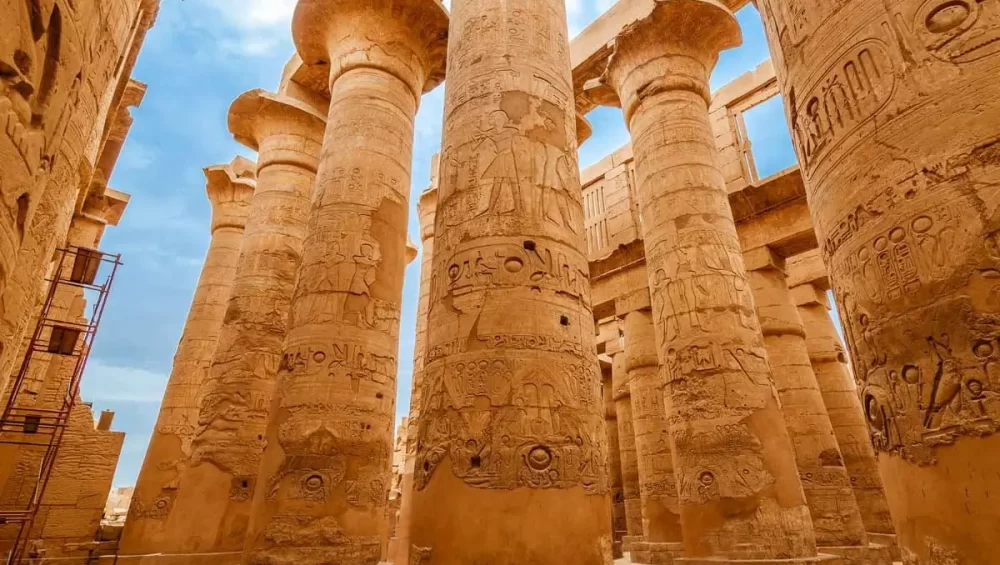Step into the grandeur of Ancient Egypt by exploring the Karnak Temple, a monumental complex that stands as a testament to the architectural brilliance and spiritual devotion of one of the world’s most fascinating civilizations. Located near Luxor in southern Egypt, the Karnak Temple is not just a tourist attraction—it’s a journey through time, a place where every stone whispers tales of gods, pharaohs, and ancient rituals.
In this guide, we’ll dive deep into the wonders of the Temple, covering everything from its history to must-see highlights and travel tips. Let’s unravel the mysteries of this iconic site together!
What Is the Karnak Temple?
It is a vast complex of temples, chapels, pylons, and other structures built over 2,000 years. Dedicated primarily to Amun-Ra, the chief deity of Thebes, it’s the largest religious building ever constructed. The sheer scale and intricacy of the complex make it one of the most awe-inspiring archaeological sites in the world.
Why Visit the Karnak Temple?
- Historical Significance: A living chronicle of Egypt’s ancient history.
- Architectural Wonder: Marvel at colossal statues, towering obelisks, and intricate carvings.
- Cultural Insight: Understand the spiritual beliefs and practices of the ancient Egyptians.
A Brief History of the Karnak Temple
The construction of Karnak Temple began during the Middle Kingdom (circa 2000 BCE) and continued through the New Kingdom and beyond. Each pharaoh contributed to the complex, leaving behind unique architectural and artistic styles.
Key Historical Milestones:
- Middle Kingdom (2000 BCE): Initial construction begins under Pharaoh Senusret I.
- New Kingdom (1550-1070 BCE): Significant expansion, including the famous Great Hypostyle Hall.
- Ptolemaic Period (305-30 BCE): Further additions and renovations.
Highlights of the Karnak Temple
1. The Great Hypostyle Hall
Walk into a forest of 134 massive sandstone columns arranged in 16 rows. This hall, covering an area of 54,000 square feet, is one of the most iconic features of Karnak Temple. Look up and marvel at the intricate hieroglyphic carvings that tell stories of gods and pharaohs.
2. The Sacred Lake
The temple’s Sacred Lake was used for purification rituals and symbolic ceremonies. Surrounded by stone walls, it’s a tranquil spot that contrasts beautifully with the grandeur of the surrounding structures.
3. Obelisks of Thutmose I and Hatshepsut
The towering obelisks at Karnak stand as symbols of power and devotion. Don’t miss Hatshepsut’s obelisk, one of the tallest surviving in Egypt.
4. Avenue of Sphinxes
This grand avenue once connected Karnak Temple to the Luxor Temple. Flanked by rows of sphinx statues, it’s a breathtaking sight, especially at sunrise or sunset.
Tips for Visiting Karnak Temple
When to Visit
- Best Time: October to April, when temperatures are cooler.
- Optimal Hours: Early morning or late afternoon for fewer crowds and better lighting for photography.
Journey through Egypt in style with our curated Nile River cruise itineraries.
Getting There
The Karnak Temple is located about 2.5 kilometers from Luxor. You can reach it by taxi, tour bus, or even horse-drawn carriage.
What to Bring
- Comfortable shoes for walking.
- A hat and sunscreen to protect against the sun.
- A guidebook or audio guide for detailed explanations.
Fun Facts About the Karnak Temple
- The Largest Open-Air Museum: Karnak Temple is often referred to as the largest open-air museum in the world.
- An Astronomical Marvel: Many of the structures align with celestial events, showcasing the Egyptians’ advanced knowledge of astronomy.
- A Site for Movies: The temple has been featured in several Hollywood films, adding to its global fame.
Final Thoughts
The Karnak Temple is more than just a historical site; it’s a gateway to understanding the grandeur and mystique of Ancient Egypt. Whether you’re a history buff, a photography enthusiast, or someone seeking spiritual inspiration, this remarkable temple complex offers something unique for everyone.
Start planning your journey to the Karnak Temple today and prepare to be amazed by its timeless beauty and profound history. It’s not just a visit—it’s an experience that will leave you in awe!
Ready to explore more wonders of Egypt? Check out our exclusive Egypt travel packages and expert guides to make your trip unforgettable!




